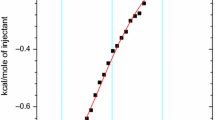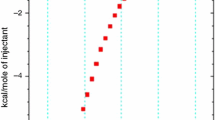Abstract
Isothermal titration calorimetry (ITC) was used to characterize inclusion complex formation of natural cyclodextrins (α- and β-cyclodextrin) with three drugs ((+)brompheniramine, (±)brompheniramine, cyclopentolate) in aqueous solutions. ITC measurements were carried out at 298.15 K on a Microcal OMEGA ultrasensitive titration calorimeter (MicroCal Inc.). The experimental data were analyzed on the basis of the model of a single set of identical sites (ITC tutorial guide). β-CD forms inclusion complexes of stoichiometry 1:1 with the all investigated drugs. In turn, smaller molecule of α-CD forms inclusion complexes of two different stoichiometry: with bigger molecules ((+)brompheniramine and (±)brompheniramine) of a stoichiometry 2:1 and with smaller molecules (cyclopentolate) of a stoichiometry 1:2. Based on the experimental values of equilibrium constant (K) and enthalpy of complex formation (ΔH), the Gibbs energy of complex formation (ΔG), and the entropy of complex formation (ΔS), have been calculated, for all the investigated systems. Obtained results showed that complex formation of β-CD (bigger molecule with wider cavity compared to β-CD) with both (+)brompheniramine, (±)brompheniramine, and cyclopentolate is enthalpy driven while complexes of α-CD with the all investigated drugs are enthalpy-entropy stabilized. This indicated that the difference in the cavity dimensions is reflecting in different driving forces of complex formation and binding modes what resulted in different stoichiometry of the obtained inclusion complexes.




Similar content being viewed by others
References
Singh R, Bharti N, Madan J, Hiremath SN. Characterization of cyclodextrin inclusion complexes—a review. J Pharm Sci Tech. 2010;2:171–83.
Rekharsky MV, Inoue Y. Complexation thermodynamics of cyclodextrins. Chem Rev. 1998;98:1875–917.
Del Valle EMM. Cyclodextrins and their uses: a review. Proc Biochem. 2004;39:1033–46.
Loftssan T, Brewster ME. Pharmaceutical application of cyclodextrins 1. Solubilization and stabilization. J Pharm Sci. 1996;85:1017–25.
Rajewski RA, Stella VJ. Pharmaceutical application of cyclodextrins 2. In vivo. Drug delivery. J Pharm Sci. 1996;85:1142–69.
Duchene D, Vaution C, Glomot F. Cyclodextrin, their value in pharmaceutical technology. Drug Dev Ind Pharm. 1988;12:2193–215.
Marzouqi AHA, Shehatta J, Jobe B, Dowaidar A. Phase solubility and inclusion complex of itraconazole with ß-cyclodextrin using supercritical carbon dioxide. J Pharm Sci. 2006;95:292–304.
Tayade PT, Vavia PR. Inclusion complexes of ketoprofen with β-cyclodextrins: oral pharmacokinetics of Ketoprofen in human. Indian J Pharm Sci. 2006;68:164–70.
Sinha VR, Anitha R, Ghosh S, Nanda A, Kumria R. Complexation of celecoxib with ß-cyclodextrin: characterization of the interaction in solution and in solid state. J Pharm Sci. 2005;94:676–87.
Tomren MA, Masson M, Loftsson T, Tonnesen HH. Studies on curcumin and curcuminoids XXXI. Symmetric and asymmetric curcuminoids: stability, activity and complexation with cyclodextrin. Int J Pharm. 2007;338:27–34.
Uekama K, Hirayama F, Otagiri M, Yamasaki M. Inclusion complexations of steroid hormones with cyclodextrins in water and in solid phase. Int J Pharm. 1982;10:1–15.
Beni S, Szakacs Z, Csernak O, Barcza L, Noszal B. Cyclodextrin/Imatinib complexation: binding mode and charge dependent stabilities. Eur J Pharm Sci. 2007;30:167–74.
Muller BK, Ritter H. Scrutinizing ITC-study on the formation of inclusion complexes of nonionic surfactant triton X-100 and cyclodextrins. J Incl Phenom Macrocycl Chem. 2011. doi 10.1007/s10847-011-9955-0.
Stojanov M, Wimmer R, Larsen KL. Study of the inclusion complexes formed between cetirizine and α-, β-, and γ-cyclodextrin and evaluation on their taste-masking properties. J Phar Sci. 2011;100:3177–85.
Bouchemal K. New challenges for pharmaceutical formulations and drug delivery systems characterization using isothermal titration calorimetry. Drug Discov Today. 2008;13:960–72.
Castronuovo G, Niccoli M. Thermodynamics of inclusion complexes of natural and modified cyclodextrins with propranolol in aqueous solution at 298 K. Bioorg Med Chem. 2006;14:3883–7.
Denadai AM, Teixeira KI, Santoro MM, Pimenta AM, Cortes ME, Sinisterra RD. Supramolecular self-assembly of beta-cyclodextrin: an effective carrier of the antimicrobial agent chlorhexidine. Carbohyd Res. 2007;342:2286–96.
Illapakurthy AC, Wyandt CM, Stodghill SP. Isothermal titration calorimetry method for determination of cyclodextrin complexation thermodynamics between artemisinin and naproxen under varying environmental conditions. Eur J Pharm Biopharm. 2005;59:325–32.
Nilsson M, Valente AJ, Olofsson G, Soderman O, Bonini M. Thermodynamic and kinetic characterization of host-guest association between bolaform surfactants and alpha- and beta-cyclodextrins. J Phys Chem B. 2009;112:11310–6.
Sun DZ, Li L, Qiu XM, Liu F, Yin BL. Isothermal titration calorimetry and 1H NMR studies on host-guest interaction of paeonol and two of its isomers with beta-cyclodextrin. Int J Pharm. 2006;316:7–13.
Roy AK, Guillory JK. The effect of cyclodextrins on the aqueous stability of cyclopentolate hydrochloride. Int J Pharm. 1996;138:37–43.
Chankvetadze B, Burjanadze N, Maynard DM, Bergander K, Bergenthal D, Blaschke G. Comparative enantioseparations with native β-cyclodextrin and heptakis-(2–0-methyl-3,6-di-o-sulfo)-β-cyclodextrin in capillary electrophoresis. Electrophoresis. 2002;23:3027–34.
Kwaterczak A, Duszczyk K, Bielejewska A. Comparison of chiral separation of basic drugs in capillary electrophoresis and liquid chromatography using neutral and negatively charged cyclodextrins. Anal Chima Acta. 2009;645:98–104.
Asztemborska M, Bielejewska A, Duszczyk K, Sybilska D. Comparative study on camphor enantiomers behavior under the conditions of gas-liquid chromatography and reversed-phase high-performance liquid chromatography systems modified with α- and β-cyclodextrin. J Chrom A. 2000;874:73–80.
Acknowledgements
This study was partially supported by the European Union within European Regional Development Fund, through grant Innovative Economy (POIG.01.01.02-14-102/09).
Author information
Authors and Affiliations
Corresponding author
Rights and permissions
About this article
Cite this article
Wszelaka-Rylik, M., Gierycz, P. Isothermal titration calorimetry (ITC) study of natural cyclodextrins inclusion complexes with drugs. J Therm Anal Calorim 111, 2029–2035 (2013). https://doi.org/10.1007/s10973-012-2251-4
Received:
Accepted:
Published:
Issue Date:
DOI: https://doi.org/10.1007/s10973-012-2251-4




